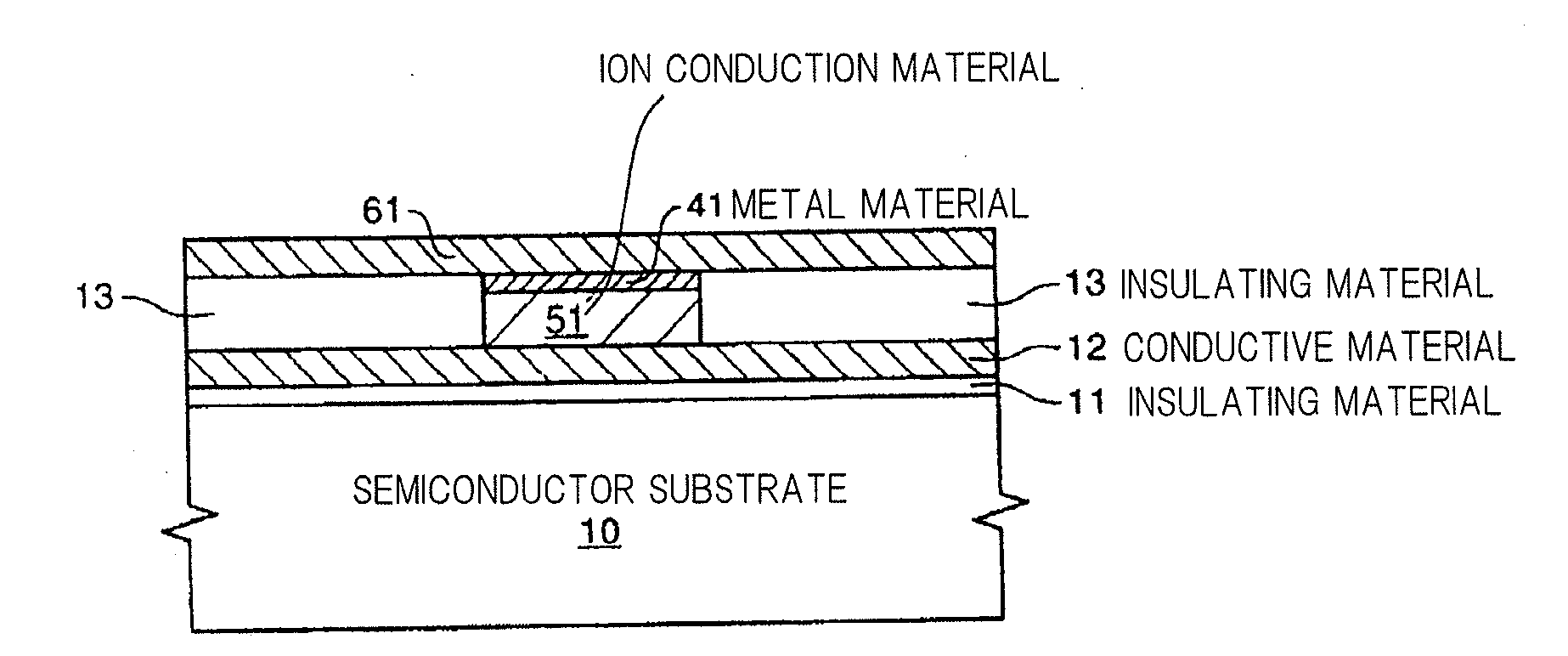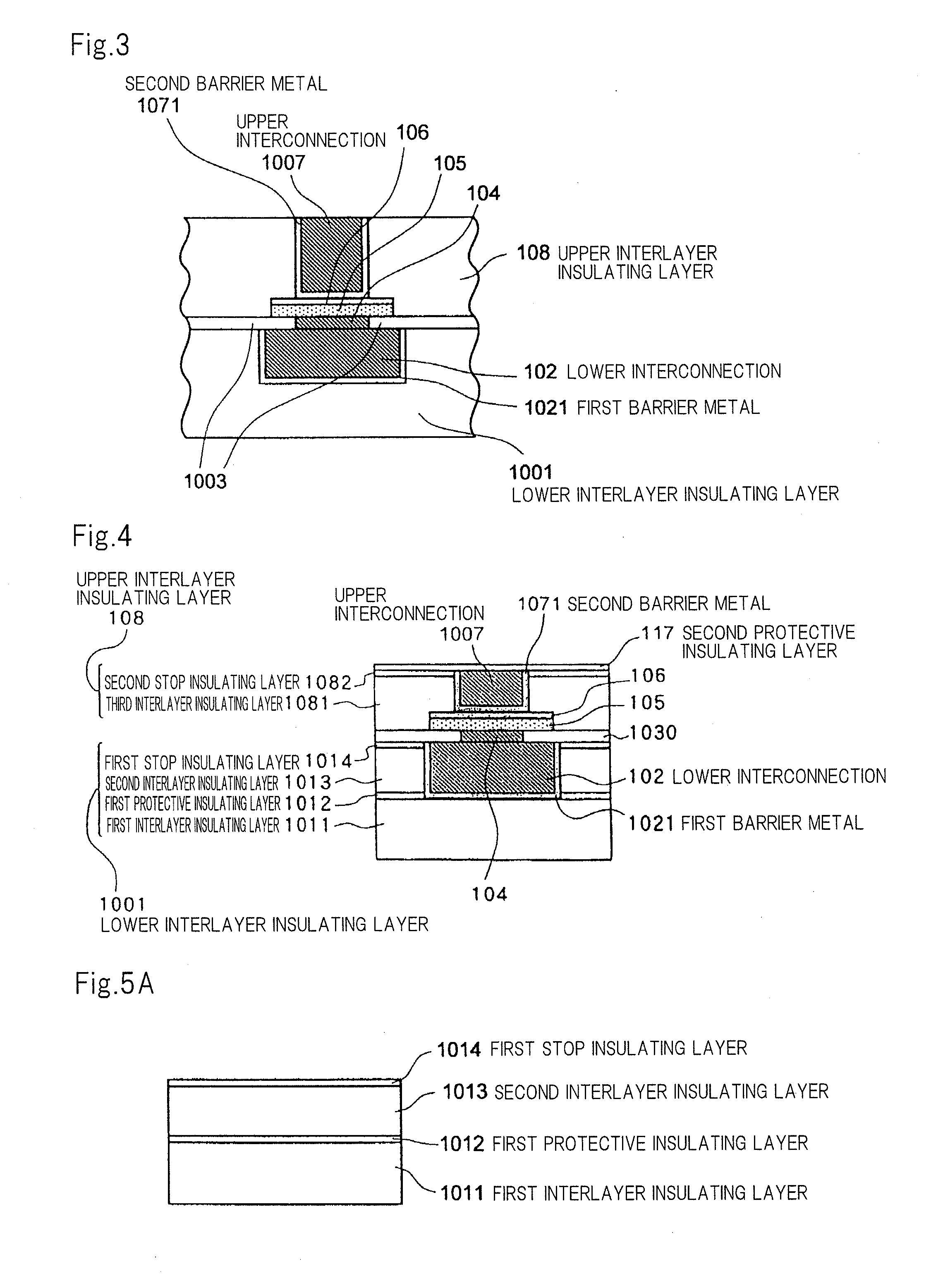Switching device, semiconductor device, programmable logic integrated circuit, and memory device
a technology of programmable logic and semiconductors, applied in semiconductor devices, bulk negative resistance effect devices, electrical appliances, etc., can solve the problems of shortening the service life of interconnections, deteriorating interconnections, metal contamination, etc., to prevent metal ions from being absorbed, prevent metal ions, and high reliability
- Summary
- Abstract
- Description
- Claims
- Application Information
AI Technical Summary
Benefits of technology
Problems solved by technology
Method used
Image
Examples
first exemplary embodiment
[0056]The configuration of a switching device according to the present exemplary embodiment will be described below. The switching device according to the present exemplary embodiment comprises a two-terminal switch. FIG. 3 is a cross-sectional view showing a configurational example of the switching device according to the present exemplary embodiment. As shown in FIG. 3, the switching device comprises first insulating layer 1003 having an opening, first electrode 104 embedded in the opening, ion conduction layer 105 disposed in contact with the upper surface of first electrode 104, and second electrode 106 disposed in contact with the upper surface of ion conduction layer 105. In FIG. 3, first electrode 104, ion conduction layer 105, and second electrode 106 are stacked on a base body. The ion conduction layer is also referred to as an ion conductor or a solid-state electrolytic layer. The term “ion conduction layer” or “ion conductor” will be used below.
[0057]First electrode 104 i...
example 1
[0092]The present example represents a configurational example of the switching device according to the first exemplary embodiment. FIG. 4 is a cross-sectional view showing the configuration of a switching device according to the first example.
[0093]As shown in FIG. 4, the switching device is basically the same structure as the structure shown in FIG. 3. The switching device includes, on a base body for providing a multilayer interconnection structure, first electrode 104 embedded in an opening in diffusion prevention layer 1030 which corresponds to first insulating layer 1003 shown in FIG. 3, ion conduction layer 105 disposed in contact with the upper surface of first electrode 104, and second electrode 106 covering the upper surface of ion conduction layer 105. The opening in diffusion prevention layer 1030 comprises a through hole as with the structure shown in FIG. 3.
[0094]The base body on which the switching device is disposed comprises a silicon substrate (not shown), semicond...
example 2
[0104]The present example represents a first modification of the switching device according to the first exemplary embodiment. FIG. 6 is a cross-sectional view showing the configuration of a switching device according to the present example. According to the present example, second electrode 106 covers all the side and upper surfaces of ion conduction layer 105. This structure is effective to prevent copper ions dissolved into the ion conduction layer from being diffused laterally and leaking out of the ion conduction layer.
[0105]The structure according to the present example can be produced by modifying [Step D] of Example 1 as follows:
[0106][Step D-1: Formation of the ion conduction layer and the second electrode] A tantalum oxide layer for forming ion conduction layer 105 is deposited to a thickness of 15 nm on first electrode 104 by the sputtering or CVD process. Using the photolithographic technology and the etching technology, ion conduction layer 105 is processed into a shape...
PUM
 Login to View More
Login to View More Abstract
Description
Claims
Application Information
 Login to View More
Login to View More - R&D
- Intellectual Property
- Life Sciences
- Materials
- Tech Scout
- Unparalleled Data Quality
- Higher Quality Content
- 60% Fewer Hallucinations
Browse by: Latest US Patents, China's latest patents, Technical Efficacy Thesaurus, Application Domain, Technology Topic, Popular Technical Reports.
© 2025 PatSnap. All rights reserved.Legal|Privacy policy|Modern Slavery Act Transparency Statement|Sitemap|About US| Contact US: help@patsnap.com



